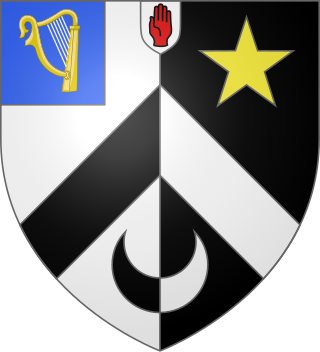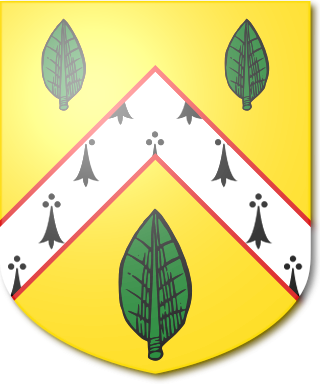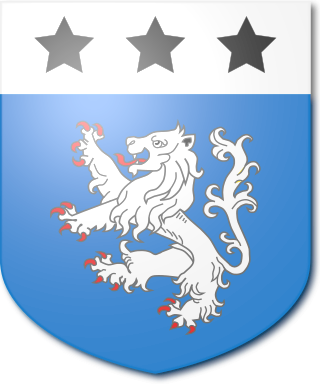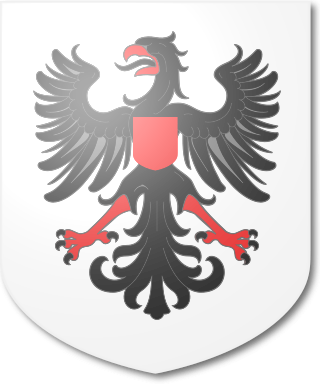
The Bunbury Baronetcy, of Bunbury, Oxon and Stanney Hall in the County of Chester, is a title in the Baronetage of England. It was created on 29 June 1681 for Thomas Bunbury, Sheriff of Cheshire from 1673 to 1674 and the member of an ancient Cheshire family. His grandson, Henry, the third Baronet, and great-grandson, the fourth Baronet, both sat as Members of Parliament for Chester. The latter died unmarried at an early age and was succeeded by his younger brother, the fifth Baronet. He was a clergyman. On his death in 1764 the title passed to his eldest son, the sixth Baronet. He represented Suffolk in the House of Commons for over forty years but is best remembered for his marriage to Lady Sarah Lennox. He died childless in 1821 and was succeeded by his nephew, the seventh Baronet. He was the son of Henry Bunbury, younger son of the fifth Baronet. The seventh Baronet was a distinguished soldier and politician. His eldest son, the eighth Baronet, was High Sheriff of Suffolk in 1868, and Fellow of the Royal Society. He died childless in 1886 and was succeeded by his younger brother, the ninth Baronet. He was Liberal Member of Parliament for Bury St Edmunds. He died unmarried in 1895 and was succeeded by his nephew, the tenth Baronet. He was the son of Colonel Henry William St Pierre Bunbury, third son of the seventh Baronet. He served as High Sheriff of Suffolk in 1908 and was a Deputy Lieutenant of the county. On his death in 1930 the title passed to his son, the eleventh Baronet. He was High Sheriff of Suffolk in 1936 and was a Deputy Lieutenant of the county. His son, the twelfth Baronet, was High Sheriff of Suffolk in 1972. As of 2014 the title was held by the latter's second but eldest surviving son, the thirteenth Baronet, who succeeded in 1985.

The Alexander, later Cable-Alexander Baronetcy, of the City of Dublin, is a title in the Baronetage of the United Kingdom. It was created on 11 December 1809 for William Alexander, Lord Mayor of Dublin. The second Baronet was a Director of the Bank of Ireland. The third Baronet was Attorney-General to Albert Edward, Prince of Wales, later Edward VII. The seventh Baronet assumed in 1931 by deed poll the additional surname of Cable. As of 31 December 2013 the present Baronet has not successfully proven his succession and is therefore not on the Official Roll of the Baronetage, with the baronetcy considered dormant.

There have been four baronetcies created for persons with the surname Hope, three in the Baronetage of Nova Scotia and one in the Baronetage of the United Kingdom. As of 2010 one creation is extant, one dormant and two extinct.

The Edge Baronetcy, of Ribble Lodge in Lytham St Annes in the County Palatine of Lancaster, is a title in the Baronetage of the United Kingdom. It was created on 9 June 1937, for the Liberal politician Sir William Edge. He represented Bolton and Bosworth in the House of Commons.

The Broadbent Baronetcy, of Longwood in the Parish of Huddersfield in the West Riding of the County of York, and of Brook Street, in the Parish of St George Hanover Square in the County of London, is a title in the Baronetage of the United Kingdom. It was created on 10 August 1893 for the noted physician William Broadbent. The title descended from father to son until the death of his grandson, the third Baronet, in 1987. The late Baronet was succeeded by his first cousin once removed, the fourth Baronet. He was the grandson of Walter Broadbent, third son of the first Baronet.

The Edwards-Moss Baronetcy, of Roby Hall in the parish of Huyton-cum-Roby in the County Palatine of Lancaster, is a title in the Baronetage of the United Kingdom. It was created on 23 December 1868 for Thomas Edwards-Moss. Born Thomas Moss, he had assumed by Royal licence the additional surname of Edwards in 1851, having married Amy Charlotte, daughter and heiress of Richard Edwards of Roby Hall, Lancashire. The presumed fifth Baronet does not use his title. As of 2021 he had not successfully proven his succession, and is therefore not on the Official Roll of the Baronetage, with the baronetcy considered dormant.

The Hammick Baronetcy, of Cavendish Square, London, is a title in the Baronetage of the United Kingdom. It was created on 25 July 1834 for the noted surgeon and physician Stephen Hammick.

The Macgregor Baronetcy, of Savile Row in the County of Middlesex, is a title in the Baronetage of the United Kingdom. It was created on 17 March 1828 for Patrick Macgregor, Serjeant-Surgeon to King George IV. Charles Reginald Macgregor (1847–1902), second son of the third Baronet, was a Brigadier-General in the Army.

The Couper Baronetcy is a title in the Baronetage of the United Kingdom. It was created on 23 June 1841 for George Couper. He was a colonel in the Army and fought in the Peninsular War, served as Military Secretary to the Governor Generals of Canada, Sir James Kempt and Lord Durham, and was Comptroller of the Household and Equerry to Her Royal Highness the Duchess of Kent. The second Baronet was an administrator in India and served as Governor of the North-West Provinces between 1877 and 1882. Another member of the family to gain distinction was James Kempt Couper, second son of the first Baronet. He was a general in the Army.

The Currie Baronetcy is a title in the Baronetage of the United Kingdom. It was created on 11 January 1847 for Frederick Currie, Foreign Secretary to the Indian Government and a member of the Supreme Council of India. He was a grandson of William Currie (1721–1781), nephew of William Currie (1756–1829), who was Member of Parliament for Upper Gatton and Winchelsea, and the brother of Vice-Admiral Mark John Currie.

The Muir Mackenzie Baronetcy, of Delvine in the County of Perth, is a title in the Baronetage of the United Kingdom. It was created on 9 November 1805 for Alexander Muir Mackenzie. Born Alexander Muir, he had assumed the additional surname of Mackenzie on succeeding to the estates of his great-uncle John Mackenzie, of Delvine, Perthshire, third son of Sir Kenneth Mackenzie, 1st Baronet, of Coul.

There have been three baronetcies created for persons with the surname Carew, two in the Baronetage of England prior to 1707, one in the Baronetage of Great Britain.
There have been three baronetcies created for persons with the surname Maitland, two in the Baronetage of Nova Scotia and one in the Baronetage of the United Kingdom. Two of the creations are extant as of 2008 while the other is either dormant or extinct.
The chiefs of the Scottish highland Clan Mackenzie were historically known as the Mackenzies of Kintail. By tradition the Mackenzie chiefs descend from Kenneth Mackenzie, 1st of Kintail however their earliest ancestor proven by contemporary evidence is Alexander Mackenzie, 6th of Kintail. The chiefly line became the Earls of Seaforth during the 17th century but this title was later forfeited in the 18th century due to support of the Jacobite rising of 1715. The current official chief of the Clan Mackenzie is John Ruaridh Grant Mackenzie, 5th Earl of Cromartie.

The Robinson Baronetcy, of Toronto in Canada, was created in the Baronetage of the United Kingdom on 21 September 1854 for the Canadian lawyer and politician John Robinson.

The InglisBaronetcy, of Gairloch, Ross-shire, was created in the Baronetage of Nova Scotia for Kenneth Mackenzie, on 22 February 1703. It is now known as Inglis of Glencorse, and the baronetage is listed as vacant.

The Ramsay baronetcy, of Bamff in the County of Perth, was created in the Baronetage of Nova Scotia on 3 December 1666 for Gilbert Ramsay. The title became extinct on the death of the twelfth Baronet in 1986.
The Ramsay baronetcy, of Balmain in the County of Kincardine, was created in the Baronetage of the United Kingdom on 13 May 1806 for Alexander Ramsay.
The Mackenzie baronetcy, of Scatwell in the County of Ross, was created in the Baronetage of Nova Scotia on 22 February 1703 for Kenneth Mackenzie, who represented Ross-shire in the Scottish Parliament. He was a descendant of Kenneth Mackenzie, brother of the 1st Baronet of the 1628 creation. The 5th Baronet represented Ross-shire in the British Parliament and was Lord Lieutenant of Ross-shire.

The Mackenzie baronetcy, of Glen Muick in the County of Aberdeen, was created in the Baronetage of the United Kingdom on 21 March 1890 for James Thompson Mackenzie, a Deputy Lieutenant for Ross-shire and Middlesex. The 3rd Baronet was a Colonel in the Scots Guards and courtier.

















